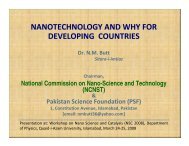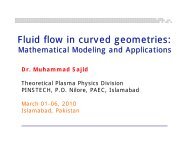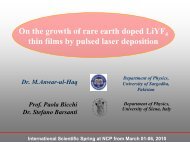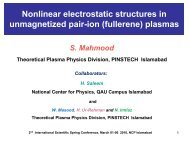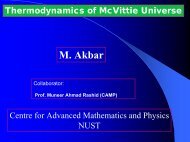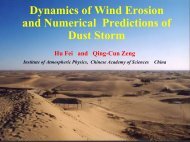Size effects on multiferroic Behavior of BiFeo3 nanoparticles
Size effects on multiferroic Behavior of BiFeo3 nanoparticles
Size effects on multiferroic Behavior of BiFeo3 nanoparticles
Create successful ePaper yourself
Turn your PDF publications into a flip-book with our unique Google optimized e-Paper software.
<str<strong>on</strong>g>Size</str<strong>on</strong>g> <str<strong>on</strong>g>effects</str<strong>on</strong>g> <strong>on</strong> <strong>multiferroic</strong><br />
<strong>Behavior</strong> <strong>of</strong> BiFeo 3 <strong>nanoparticles</strong><br />
Alina Manzoor and S. K. Hasanain<br />
Magnetic Nanostructures Laboratories.<br />
Physics Department<br />
Quaid-I-Azam University Islamabad.<br />
1
Multiferroics<br />
‣ Multiferroics are materials having coexistence <strong>of</strong><br />
ferroelectricity and ferromagnetism.<br />
‣ Very few such materials exist.<br />
‣ BiFeO 3 is <strong>on</strong>e <strong>of</strong> these few.<br />
‣ Ferroelectricity: The sp<strong>on</strong>taneous alignment <strong>of</strong> electric<br />
dipoles below a critical temperature T c .<br />
T>T c<br />
T
‣ Ferroelectricity requires the presence <strong>of</strong> an electric<br />
dipole moment in a unit cell.<br />
‣ <strong>on</strong>ly possible if the centers <strong>of</strong> positive and negative<br />
charge do not coincide.<br />
‣ Only certain lattice symmetries allow for FE to occur.<br />
However,<br />
‣ Those that allow FE, do not allow FM.<br />
‣ Hence FM & FE do not coexist in general.
‣ However, AFM & FE can and do coexist. Many examples<br />
<strong>of</strong> such systems exist.<br />
‣ In some cases a weak FM is seen to coexist with FE.<br />
BiFeO 3 is <strong>on</strong>e <strong>of</strong> the few known, in which FE with a FM<br />
behavior as well.<br />
Because <strong>of</strong> the many important applicati<strong>on</strong>s <strong>of</strong> MF in<br />
read-write technologies, much effort to understand and<br />
improve the <strong>multiferroic</strong>s characteristics.<br />
4
Introducti<strong>on</strong> to BiFeO 3<br />
‣ Rhombohedrally distorted perovskite structure<br />
with lattice parameters, a = b ≠ c.<br />
‣ Canted, spiral G-type, G<br />
AFM order.<br />
Structure <strong>of</strong> R3c BiFeO 3 . Notice the positi<strong>on</strong> <strong>of</strong> the oxygen octahedra<br />
relative to the Bi frame work; in the ideal cubic perovskite structure<br />
the oxygen i<strong>on</strong>s would occupy the face centered sites.
Spin structure AFM (in plane; spiral)<br />
Because <strong>of</strong> spin-lattice interacti<strong>on</strong>s the AFM spins are<br />
pulled out <strong>of</strong> perfect antiparallel alignments;<br />
A small net moment results; Weak ferromagnetism.<br />
Evidence for magneto-electric coupling. The electric and<br />
magnetic moments are coupled via the lattice.<br />
Weak FM & FE<br />
(a) The magnetic<br />
moments, MFe1 and MFe2, <strong>of</strong> the two<br />
ir<strong>on</strong> atoms in the unit<br />
cell are oriented antiferromagnetically and<br />
collinearly in the [111]<br />
plane, allowing weak ferromagnetism by<br />
symmetry. (b) Calculated<br />
magnetic structure including the spin-orbit<br />
interacti<strong>on</strong>: The two ir<strong>on</strong><br />
magnetic moments rotate in the [111]<br />
plane so that there is a resulting<br />
sp<strong>on</strong>taneous magnetizati<strong>on</strong>, M.
‣Since Ferroelectric behavior known to be<br />
str<strong>on</strong>gly sensitive to strains, we may expect the<br />
<strong>multiferroic</strong> behavior to be str<strong>on</strong>gly affected in<br />
<strong>nanoparticles</strong>.<br />
Why<br />
‣Nanoparticles<br />
→ small sizes, large surface area → strains are<br />
enhanced → can affect FE &FM.<br />
→ large number <strong>of</strong> O vacancies → Affect the FM.<br />
7
Different studies <strong>on</strong> BiFeO 3 <strong>nanoparticles</strong> do<br />
show evidence <strong>of</strong> Magneto-electric electric coupling.<br />
Enhanced <str<strong>on</strong>g>effects</str<strong>on</strong>g> in small particles.<br />
But reas<strong>on</strong> not well understood.<br />
<str<strong>on</strong>g>Size</str<strong>on</strong>g> and strains or<br />
<str<strong>on</strong>g>Size</str<strong>on</strong>g> and O vacancies.<br />
We investigate with this in mind.<br />
8
Results:<br />
‣ Particles made by s<strong>of</strong>t chemical route.<br />
‣ <str<strong>on</strong>g>Size</str<strong>on</strong>g> range; 11nm to 29nm.<br />
‣ Two annealing enviorments.<br />
‣ Annealed in air (more O vacancies).<br />
‣ Annealed in O (less O vacancies).<br />
‣ Measurements <strong>of</strong> M(H), ε’(T),<br />
ε”(T),<br />
ρ.<br />
9
Added under<br />
uniform stirring<br />
Tartaric acid<br />
(C 4 H 6 O 6 )<br />
(3.0018 g)<br />
Chelating<br />
2N soluti<strong>on</strong> <strong>of</strong><br />
HNO 3<br />
in100ml <strong>of</strong><br />
distilled<br />
Water<br />
Fluffy<br />
green<br />
agent powder<br />
MMM Evaporati<strong>on</strong><br />
C<strong>on</strong>stant stirring<br />
and heating at<br />
150 0 C<br />
Mixed soluti<strong>on</strong><br />
<strong>of</strong> metal<br />
nitrates +<br />
tartaric acid<br />
Nitrates removed from BiFeO 3 powder by<br />
annealing at high temperature (450 0 C-600 0 C)<br />
: Block diagram for the preparati<strong>on</strong> <strong>of</strong> BiFeO 3<br />
<strong>nanoparticles</strong> by evaporati<strong>on</strong> method
Crystal structure<br />
X-RD data<br />
Intensity(a.u)<br />
---450-O<br />
---500-O<br />
---550-O<br />
---600-O<br />
(012)<br />
(104)<br />
(110)<br />
(202)<br />
(024)<br />
(122)<br />
(018)<br />
(300)<br />
10 20 30 40 50 60<br />
2θ (degree)<br />
X-ray diffracti<strong>on</strong> pattern <strong>of</strong> BiFeO 3 samples annealed<br />
in oxygen for 2 hours at various temperature<br />
11
M-H H LOOP<br />
0.2<br />
11 nm<br />
13 nm<br />
21 nm<br />
0.1<br />
M (emu/g)<br />
0.0<br />
0.03<br />
-0.1<br />
M (emu/g)<br />
0.00<br />
-0.2<br />
-0.03<br />
-2000 0 2000<br />
H (Oe)<br />
-10000 -5000 0 5000 10000<br />
H (Oe)<br />
Magnetic hysteresis loops for air annealed samples at 300 K<br />
12
1.5<br />
1.0<br />
17 nm<br />
20 nm<br />
29 nm<br />
0.5<br />
M (emu/g)<br />
0.0<br />
-0.5<br />
M (emu/g)<br />
0.00<br />
20 nm<br />
29 nm<br />
-1.0<br />
-1.5<br />
0<br />
H (Oe)<br />
-10000 -5000 0 5000 10000<br />
H (Oe)<br />
Magnetic Hysteresis loops for oxygen annealed samples at 300K
Derived room temperature magnetic parameters for air annealed<br />
samples<br />
Particle size<br />
(d, nm)<br />
Ms at 10<br />
KOe<br />
(emu/g)<br />
Ms<br />
(<br />
Mr/Ms<br />
11<br />
13<br />
21<br />
0.2<br />
0.1<br />
0.076<br />
0.01<br />
0.0056<br />
0.0043<br />
0.003<br />
0.007<br />
0.009<br />
Derived room temperature magnetic parameter for oxygen<br />
annealed samples<br />
Particle size<br />
(d, nm)<br />
Ms at 10<br />
KOe<br />
(emu/g)<br />
Ms<br />
(<br />
Mr/Ms<br />
17<br />
20<br />
29<br />
1.1<br />
0.15<br />
0.089<br />
0.062<br />
0.0085<br />
0.0049<br />
0.005<br />
0.009<br />
0.005
Dielectric measurements<br />
36<br />
d = 21nm<br />
18<br />
17<br />
34<br />
16<br />
ε<br />
32<br />
15<br />
30<br />
T N<br />
~560K<br />
(ε')<br />
14<br />
28<br />
13<br />
12<br />
26<br />
Frequency=10KHz<br />
11<br />
Frequency=10kHz<br />
24<br />
300 350 400 450 500 550 600 650<br />
T(K)<br />
300 350 400 450 500 550 600 650<br />
T(k)<br />
Temperature dependence <strong>of</strong> real part <strong>of</strong><br />
dielectric c<strong>on</strong>stant for 21nm air annealed sample<br />
Temperature dependence <strong>of</strong> real part <strong>of</strong> dielectric<br />
c<strong>on</strong>stant for 29nm oxygen annealed sample
7.0<br />
6.5<br />
Frequency=10kHz<br />
2.4<br />
6.0<br />
2.2<br />
(ε")<br />
5.5<br />
5.0<br />
T=490k<br />
(ε")<br />
2.0<br />
4.5<br />
ΔT=70k<br />
T N<br />
=560K<br />
1.8<br />
T=565k<br />
4.0<br />
1.6<br />
3.5<br />
Frequency 10kHz<br />
3.0<br />
300 350 400 450 500 550 600 650<br />
T(K)<br />
1.4<br />
300 350 400 450 500 550 600 650<br />
T(k)<br />
Temperature dependence <strong>of</strong> imaginary part <strong>of</strong><br />
dielectric c<strong>on</strong>stant for 21nm air annealed<br />
sample<br />
Temperature dependence <strong>of</strong> imaginary part <strong>of</strong> dielectric<br />
c<strong>on</strong>stant for 29nm oxygen annealed sample
Variati<strong>on</strong> <strong>of</strong> dielectric c<strong>on</strong>stant with different sizes<br />
80<br />
75<br />
70<br />
65<br />
11nm<br />
13nm<br />
21nm<br />
16<br />
14<br />
12<br />
11nm<br />
13nm<br />
21nm<br />
60<br />
10<br />
ε'<br />
55<br />
50<br />
45<br />
ε″<br />
8<br />
6<br />
40<br />
4<br />
35<br />
2<br />
30<br />
25<br />
300 350 400 450 500 550 600 650<br />
T(K)<br />
Freq=10kHz<br />
0<br />
300 350 400 450 500 550 600 650<br />
T(K)<br />
Temperature dependence <strong>of</strong> real part<br />
<strong>of</strong> dielectric c<strong>on</strong>stant for air annealed<br />
samples <strong>of</strong> various sizes<br />
Temperature dependence <strong>of</strong> imaginary part<br />
<strong>of</strong> dielectric c<strong>on</strong>stant for air annealed<br />
samples <strong>of</strong> various sizes
55<br />
50<br />
17nm<br />
20nm<br />
29nm<br />
16<br />
14<br />
17nm<br />
20nm<br />
29nm<br />
45<br />
12<br />
40<br />
10<br />
35<br />
ε''<br />
8<br />
ε'<br />
30<br />
6<br />
25<br />
4<br />
20<br />
2<br />
15<br />
0<br />
10<br />
300 350 400 450 500 550 600 650<br />
T(K)<br />
300 350 400 450 500 550 600 650<br />
T(K)<br />
Temperature dependence <strong>of</strong> real part<br />
<strong>of</strong> dielectric c<strong>on</strong>stant for oxygen<br />
annealed samples <strong>of</strong> various sizes.<br />
Temperature dependence <strong>of</strong> imaginary<br />
part <strong>of</strong> dielectric c<strong>on</strong>stant for oxygen<br />
annealed samples <strong>of</strong> various sizes
Coincidence <strong>of</strong> anomalies in ε˝(T) with the magnetic<br />
ordering temperatures. Evidence <strong>of</strong> M-E coupling.<br />
Larger FM in smaller particles<br />
Enhanced <str<strong>on</strong>g>effects</str<strong>on</strong>g> <strong>of</strong> M-E coupling in O- annealed<br />
particles, particularly in smaller particles.<br />
Str<strong>on</strong>g M-E <str<strong>on</strong>g>effects</str<strong>on</strong>g> in smaller particles<br />
Could the enhanced <str<strong>on</strong>g>effects</str<strong>on</strong>g> be due to larger amount <strong>of</strong><br />
O-vacancies in smaller particles<br />
No- because <str<strong>on</strong>g>effects</str<strong>on</strong>g> are enhanced in O-annealed<br />
samples where lesser number <strong>of</strong> O vacancies are<br />
present.
Resistivity measurements<br />
7.8<br />
7.6<br />
d=29 nm<br />
ΔΕ=(0.028±0.00084)ev<br />
8.0<br />
d= 21nm<br />
ΔΕ=(0.026±0.0004)ev<br />
7.4<br />
7.9<br />
log ρ<br />
7.2<br />
7.0<br />
6.8<br />
ΔΕ=(0.37±0.0085)ev<br />
Log ρ<br />
7.8<br />
7.7<br />
6.6<br />
7.6<br />
6.4<br />
6.2<br />
0.0014 0.0016 0.0018 0.0020 0.0022 0.0024 0.0026<br />
1/T<br />
7.5<br />
0.0014 0.0016 0.0018 0.0020 0.0022 0.0024 0.0026<br />
1/T<br />
log ρ vs. 1/T plot for oxygen annealed sample<br />
log ρ vs. 1/T plot for air annealed sample
Resistivity Studies<br />
Resistivity studies across the magnetic transiti<strong>on</strong><br />
regi<strong>on</strong>.<br />
Activated behavior <strong>of</strong> ρ.<br />
Decrease in activati<strong>on</strong> energies for T
C<strong>on</strong>clusi<strong>on</strong>s<br />
Preliminary results suggest that Multiferroic <str<strong>on</strong>g>effects</str<strong>on</strong>g> are<br />
enhanced in BiFeO 3 <strong>nanoparticles</strong> with decreasing size<br />
and with removal <strong>of</strong> O vacancies.<br />
The <str<strong>on</strong>g>effects</str<strong>on</strong>g> are probably due to the enhanced strains in<br />
smaller size particles and not due to O vacancies.<br />
Suggested that the small size <strong>of</strong> NPs makes the<br />
stabilizati<strong>on</strong> <strong>of</strong> the AFM spiral more difficult. Hence FM<br />
tilting <strong>of</strong> spins becomes easier.<br />
Future work:<br />
Need to obtain quantificati<strong>on</strong> <strong>of</strong> strains in these particles.<br />
Need to study a larger range <strong>of</strong> particles and study <strong>of</strong><br />
ε(T), (T) over wider range.



